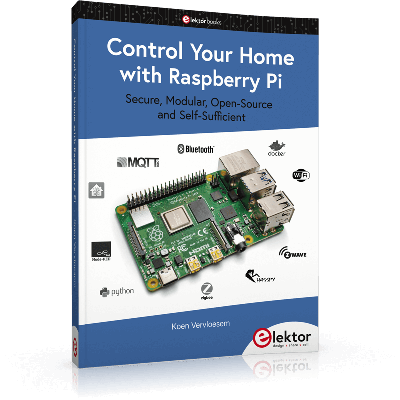Control Your Home with Raspberry Pi
Secure, Modular, Open-Source and Self-Sufficient
Ever since the Raspberry Pi was introduced, it has been used by enthusiasts to automate their homes. The Raspberry Pi is a powerful computer in a small package, with lots of interfacing options to control various devices.
This book shows you how you can automate your home with a Raspberry Pi. You’ll learn how to use various wireless protocols for home automation, such as Bluetooth, 433.92 MHz radio waves, Z-Wave, and Zigbee. Soon you’ll automate your home with Python, Node-RED, and Home Assistant, and you’ll even be able to speak to your home automation system.
All this is done securely, with a modular system, completely open-source, without relying on third-party services. You’re in control of your home, and no one else.
At the end of this book, you can install and configure your Raspberry Pi as a highly flexible home automation gateway for protocols of your choice, and link various services with MQTT to make it your own system. This DIY (do it yourself) approach is a bit more laborious than just installing an off-the-shelf home automation system, but in the process, you can learn a lot, and in the end, you know exactly what’s running your house and how to tweak it. This is why you were interested in the Raspberry Pi in the first place, right?
Turn your Raspberry Pi into a reliable gateway for various home automation protocols.
Make your home automation setup reproducible with Docker Compose.
Secure all your network communication with TLS.
Create a video surveillance system for your home.
Automate your home with Python, Node-RED, Home Assistant and AppDaemon.
Securely access your home automation dashboard from remote locations.
Use fully offline voice commands in your own language.
Title |
Control Your Home with Raspberry Pi |
Author |
Koen Vervloesem |
Publication date |
2020-08-17 |
Number of pages |
331 |
Price |
€ 37.50 |
ISBN-13 |
978-1-907920-94-3 |
ISBN-10 |
1-907920-94-3 |
Publisher |
Elektor International Media (EIM) |
You can order the book in the Elektor Store or in your favourite book store. The page in the Elektor Store also shows you the table of contents and the full introduction chapter.
The code examples from the book are available in the corresponding GitHub repository and are released under the open-source MIT license. You can also find the errata list there and a list of additional tips and interesting projects not mentioned in the book.
